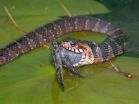(Press-News.org) Watersnakes, commonly seen in the lakes, rivers and streams of the eastern United States, are invading California waterways and may pose a threat to native and endangered species in the state, according to a University of California, Davis, study.
While scientists do not know exactly how many watersnakes are in California, roughly 300 individuals of two different species –the common watersnake and the southern watersnake -- have been found in the Sacramento area (Roseville and Folsom), and at least 150 were seen in Long Beach. Researchers suspect the nonvenomous snakes most likely were introduced by people "setting free" their pet snakes.
"The issue is not yet out of control," said lead author Jonathan Rose, a doctoral candidate in the UC Davis Graduate Group in Ecology. "However, we recommend that action be taken now to control emergent populations of these non-native snakes while they remain somewhat restricted in California. Waiting until they become entrenched could cost more ecologically and economically."
The study, published today in the journal PLOS ONE, identified areas that would be climatically suitable for the watersnakes should their populations continue to increase. It found that potential distributions of watersnakes overlap with the giant gartersnake and the California tiger salamander -- both on the federal list of threatened species -- as well as the foothill yellow-legged frog, an amphibian of conservation concern. These native species can become prey or a competing species for the invasive watersnakes.
The common watersnake not only has the potential to spread through Central California, but also farther north to Oregon's Willamette Valley and to central Washington. The southern watersnake has a more restricted climatic niche but may spread through the Central Valley, where native fish and amphibians have already suffered significant declines. The two watersnake species also frequently interbreed, which could increase their invasiveness by producing hybrid genotypes able to tolerate a broader range of climates.
"Watersnakes are not picky eaters," said co-author Brian Todd, a conservation biologist in the UC Davis Department of Wildlife, Fish and Conservation Biology. "With their predatory nature and generalist diets, our already imperiled native fish, amphibians and reptiles have much to lose should introduced watersnakes become more widespread."
Nearly half of California's amphibians are considered Species of Special Concern or are listed under the state or federal Endangered Species Act, and more than 80 percent of the state's inland fishes are of conservation concern.
INFORMATION:
Sightings of introduced watersnakes can be reported to californiawatersnakes@gmail.com.
Read the full study at http://bit.ly/1lTT0lg.
Invasive watersnakes introduced to California may pose risk to native species
Non-native watersnakes have potential to spread throughout West
2014-06-26
ELSE PRESS RELEASES FROM THIS DATE:
Sequencing efforts miss DNA crucial to bacteria's disease causing power
2014-06-26
Genomic sequencing is supposed to reveal the entire genetic makeup of an organism. For infectious disease specialists, the technology can be used to analyze a disease-causing bacterium to determine how much harm it is capable of causing and whether or not it will be resistant to antibiotics. But new research at Rockefeller University suggests that current sequencing protocols overlook crucial bits of information: isolated pieces of DNA floating outside the bacterial chromosome, the core of a cell's genetic material.
"Extensive sequencing of chromosomal DNA has been performed ...
A win-win-win solution for biofuel, climate, and biodiversity
2014-06-25
Fossil fuel emissions release billions of tons of carbon into the atmosphere each year, which is changing the climate and threatening the sustainability of life on planet Earth. In Brazil, the demand for alternative energy sources has led to an increase in biofuel crops. A new "News and Views" paper in Nature Climate Change, co-authored by Woods Hole Research Center scientists Marcia Macedo and Eric Davidson, reviews new research conducted by Brazilian colleagues demonstrating the high carbon costs of converting intact Brazilian savanna compared to the carbon gains obtained ...
Scientists develop a 'nanosubmarine' that delivers complementary molecules inside cells
2014-06-25
VIDEO:
Francisco Raymo discusses his work in this video.
Click here for more information.
CORAL GABLES, Fla. (June 25, 2014) — With the continuing need for very small devices in therapeutic applications, there is a growing demand for the development of nanoparticles that can transport and deliver drugs to target cells in the human body.
Recently, researchers created nanoparticles that under the right conditions, self-assemble – trapping complementary guest molecules within ...
NASA's STEREO maps much larger solar atmosphere than previously observed
2014-06-25
Surrounding the sun is a vast atmosphere of solar particles, through which magnetic fields swarm, solar flares erupt, and gigantic columns of material rise, fall and jostle each other around. Now, using NASA's Solar Terrestrial Relations Observatory, scientists have found that this atmosphere, called the corona, is even larger than thought, extending out some 5 million miles above the sun's surface -- the equivalent of 12 solar radii. This information has implications for NASA's upcoming Solar Probe Plus mission, due to launch in 2018 and go closer to the sun than any man-made ...
New NASA model gives glimpse into the invisible world of electric asteroids
2014-06-25
Space may appear empty -- a soundless vacuum, but it's not an absolute void. It flows with electric activity that is not visible to our eyes. NASA is developing plans to send humans to an asteroid, and wants to know more about the electrical environment explorers will encounter there.
A solar wind blown from the surface of the sun at about a million miles per hour flows around all solar system objects, forming swirling eddies and vortices in its wake. Magnetic fields carried by the solar wind warp, twist, and snap as they slam into the magnetic fields around other objects ...
Carbon-fiber epoxy honeycombs mimic the material performance of balsa wood
2014-06-25
Cambridge, Mass. – June 25, 2014 – In wind farms across North America and Europe, sleek turbines equipped with state-of-the-art technology convert wind energy into electric power. But tucked inside the blades of these feats of modern engineering is a decidedly low-tech core material: balsa wood.
Like other manufactured products that use sandwich panel construction to achieve a combination of light weight and strength, turbine blades contain carefully arrayed strips of balsa wood from Ecuador, which provides 95 percent of the world's supply.
For centuries, the fast-growing ...
Changes in forage fish abundance alter Atlantic cod distribution, affect fishery success
2014-06-25
A shift in the prey available to Atlantic cod in the Gulf of Maine that began nearly a decade ago contributed to the controversy that surrounded the 2011 assessment for this stock. A recent study of how this occurred may help fishery managers, scientists, and the industry understand and resolve apparent conflicts between assessment results and the experiences of the fishing industry.
When the dominant prey species of Atlantic cod changed from Atlantic herring to sand lance beginning in 2006, cod began to concentrate in a small area on Stellwagen Bank where they were easily ...
New insights for coping with personality changes in acquired brain injury
2014-06-25
Amsterdam, NL, June 25, 2014 – Individuals with brain injury and their families often struggle to accept the associated personality changes. The behavior of individuals with acquired brain injury (ABI) is typically associated with problems such as aggression, agitation, non-compliance, and depression. Treatment goals often focus on changing the individual's behavior, frequently using consequence-based procedures or medication. In the current issue of NeuroRehabilitation leading researchers challenge this approach and recommend moving emphasis from dysfunction to competence. ...
People with tinnitus process emotions differently from their peers, researchers report
2014-06-25
CHAMPAIGN, Ill. — Patients with persistent ringing in the ears – a condition known as tinnitus – process emotions differently in the brain from those with normal hearing, researchers report in the journal Brain Research.
Tinnitus afflicts 50 million people in the United States, according to the American Tinnitus Association, and causes those with the condition to hear noises that aren't really there. These phantom sounds are not speech, but rather whooshing noises, train whistles, cricket noises or whines. Their severity often varies day to day.
University of Illinois ...
New math technique improves atomic property predictions to historic accuracy
2014-06-25
By combining advanced mathematics with high-performance computing, scientists at the National Institute of Standards and Technology (NIST) and Indiana University (IU) have developed a tool that allowed them to calculate a fundamental property of most atoms on the periodic table to historic accuracy—reducing error by a factor of a thousand in many cases. The technique also could be used to determine a host of other atomic properties important in fields like nuclear medicine and astrophysics.*
NIST's James Sims and IU's Stanley Hagstrom have calculated the base energy levels ...
LAST 30 PRESS RELEASES:
Groundbreaking discovery turns household plastic recycling into anti-cancer medication
Blocking a key inflammatory pathway improves liver structure and vascular function in cirrhosis, study finds
Continuous spread: Raccoon roundworm detected in nine European countries
HKUST Engineering researchers developed a novel photodetector to enhance the performance of on-chip light monitoring
Strategic river sensors could have forewarned of Texas Camp flood disaster
Drone sampling of whale breath reveals first evidence of potentially deadly virus in Arctic
Roman soldiers defending Hadrian’s Wall infected by parasites, study finds
Pinochet’s prisoners were tormented with music but still found solace in it, a new book reveals
Fertility remains high in rural Tanzania despite access to family planning
AI-assisted device can improve autism care access
Kinetic careers
Uncovering how parasitic plants avoid attacking themselves to improve crop resistance
Nanoparticle vaccine strategy could protect against Ebola and other deadly filoviruses
Study finds brain care score can predict risk of stroke across racial groups
Key lung immune cells can intensify allergic reactions
Do hormones explain why women experience more gut pain?
New materials conduct ions in solids as easily as in liquids
Breakthrough of the Year: Renewable energy begins to eclipse fossil fuel-based sources
LLM use is reshaping scientific enterprise by increasing output, reducing quality and more
Introducing LightGen, a chip for ultra-fast, ultra-efficient generative AI
Astronomers see fireworks from violent collisions around nearby star
ACC/AHA issue new guideline on managing congenital heart disease in adults
Cosmic crash caught on camera
Is talented youth nurtured the wrong way? New study shows: top performers develop differently than assumed
Ants: An untapped resource in the development of antibiotics?
Archaeologists use AI to create prehistoric video game
Mitochondria migrate toward the cell membrane in response to high glucose levels
Tiny viral switch offers hope against drug-resistant bacteria
Most parents aware of early peanut introduction guidelines, but confused about details
HPV vaccine can protect against severe lesions of the vulva and vagina
[Press-News.org] Invasive watersnakes introduced to California may pose risk to native speciesNon-native watersnakes have potential to spread throughout West






